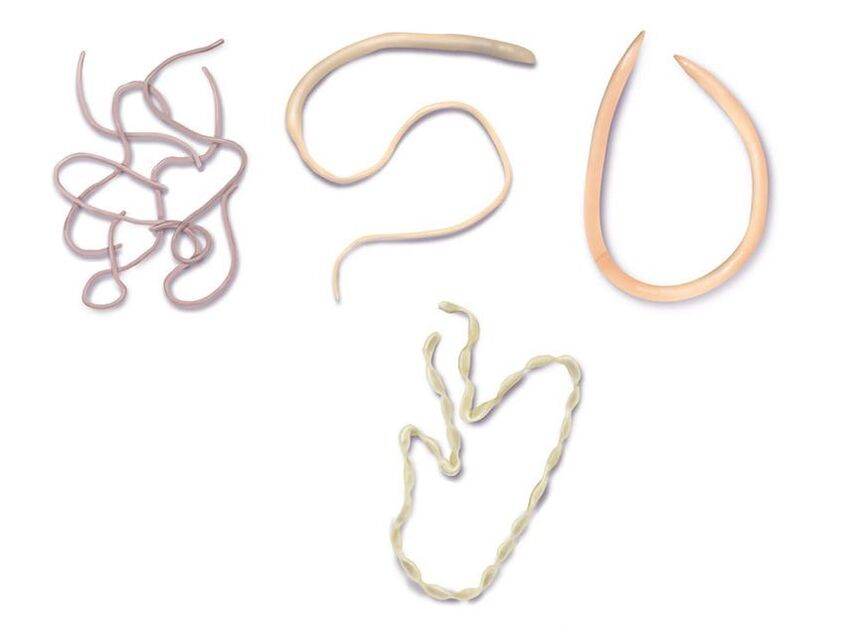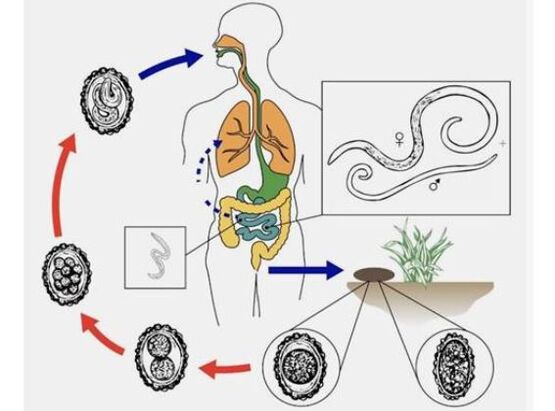Further determination of the type, number and duration of the life cycle of human helminths must be carried out through a comprehensive examination in a specialized clinic.
Types of human worms

- Nematodes, roundworms.Life cycle does not exceed 40 years; parasitic in the intestines. May affect respiratory system and stomach. Representative: pinworm, roundworm, whipworm;
- Tape parasite.They can survive in the intestines and migrate throughout the body for about 20 years. Large sizes can reach 8-10 meters. Bovine and pork tapeworm individuals, tapeworms;
- Flukes, flukes.They occur in internal organs and subcutaneous tissue. It travels through all organs and can be life-threatening.
Each of the above groups has representatives most commonly found in humans.
- roundwormsMay cause: appendicitis, jaundice, bile duct inflammation;
- Pinworm.Causes complications: gastritis, allergic reactions, neurological disorders;
- WhipwormMay cause dysentery and rectal prolapse;
- Toxocara.Manifested as vision loss, bronchitis, necrosis of pancreas, liver, kidney, and destruction of brain function;
- Echinococcus tapeworm.It causes dangers such as anaphylactic shock, hives, liver enlargement, cyst formation, and death;
- Trichinella spiralis.May cause infiltration to form, damaging the heart and brain;
- Giardia.Consequences: anemia, gastritis, Kunkel's edema, pancreatitis;
- hookworm.May cause intestinal dysfunction;
- Wide tape.Promote the development of anemia, vitamin deficiency, intestinal tissue necrosis, spinal cord injury;
- Heartworm.Can cause diseases: conjunctivitis, lymphadenitis, asthma, abscess; paragonimiasis. They can cause enteritis, bronchitis, fever, meningitis, tachycardia.
Worm infection

- Bodies of Water In most parasites, the larvae spend the intermediate stages of their life cycle in fresh and salt water. Sometimes they are found in intermediate hosts such as fish and shellfish;
- Wet sand or soil. Released with feces (mainly eggs) for further development or to find temporary carriers;
- Dirty raw vegetables, berries, fruits, herbs. Future parasites can penetrate from the soil to the surface of the product;
- Animals: Homeless and Domestic. Temporary media.
Adult Worms and Their Signs and Symptoms

How to check if you really have worms?
- Changes in appetite, including increases and decreases in appetite;
- Nervous, scared, excited. Fatigue and weakness may also occur;
- Snoring, difficulty breathing during sleep;
- intestinal problems, including diarrhea and constipation;
- abdominal bloating;
- Headache, dizziness;
- swelling of limbs;
- Itching of the anus;
- Increased body temperature;
- blood pressure fluctuations;
- rash, redness;
- feel sick and vomit;
- stomachache;
- Weak hair and nails.
Signs of parasites in children
- Intestinal dysfunction and dysbiosis;
- Bloating, gas;
- Skin inflammation, urticaria;
- Involuntary urination or urinary incontinence;
- Respiratory diseases. Bronchitis, pneumonia, asthma;
- In girls, the reproductive organs may become inflamed;
- Vomiting, nausea;
- itching and burning in the anus;
- Severe abdominal pain and cramping;
- sleep disorder;
- nervous,
- Newborns may develop serious complications or developmental delays.
Various worm tests

How can you tell if a person has helminthiasis?
- scratchThis is a traditional and simple method that involves taking a smear from the anus to determine whether eggs are present;
- Stool analysis.This method has been tested but does not always work because not all worms are found in the secretions;
- Chemistry General Blood Test.It allows you to determine the inflammatory process only through the indicator of low hemoglobin levels and also takes into account white blood cells;
- CPR Diagnosis.The method involves studying parasite DNA material found in blood and comparing it to existing samples. It can accurately determine the type of worm and its number;
- Linked immunosorbent assay.The method is also based on analysis of the patient's blood. The detection of IgM and IgG antibodies in the samples indicates the immune system's protective response to the worms.
Worms: Treatment in Adults and Children
What to do in this situation?
Only an experienced doctor can prescribe medications appropriate to the age of the patient and the degree of complications of the disease.




























